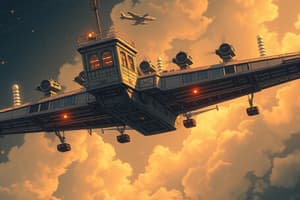Podcast
Questions and Answers
What is the primary purpose of the variable incidence stabilizer in large aircraft?
What is the primary purpose of the variable incidence stabilizer in large aircraft?
- To reduce the aircraft's yaw rate
- To minimize drag when trimming the aircraft in flight (correct)
- To provide additional lift during takeoff
- To increase the aircraft's pitch rate
What is the main characteristic of a canard wing aircraft?
What is the main characteristic of a canard wing aircraft?
- It has a small wing or horizontal airfoil that creates lift and holds the nose up (correct)
- It has a horizontal tail section that combines the action of both the horizontal stabilizer and the elevator
- It has a variable incidence stabilizer that is controlled by a motorized jackscrew
- It has a conventional wing that provides a download
What is the result of moving the control stick forward in an aircraft with a stabilator?
What is the result of moving the control stick forward in an aircraft with a stabilator?
- The stabilator moves down and increases the downward force produced by the tail
- The elevator deflects upward and the nose of the aircraft goes up
- The stabilator moves up and increases the upward force produced by the tail
- The elevator deflects downward and the nose of the aircraft goes down (correct)
What is the purpose of aileron-rudder coupling in an aircraft?
What is the purpose of aileron-rudder coupling in an aircraft?
What is the primary function of the stabilator in an aircraft?
What is the primary function of the stabilator in an aircraft?
What is the result of pulling the control wheel back in an aircraft with a stabilator?
What is the result of pulling the control wheel back in an aircraft with a stabilator?
What is the main advantage of using a variable incidence stabilizer in an aircraft?
What is the main advantage of using a variable incidence stabilizer in an aircraft?
What is the effect of a canard wing on the center of gravity of an aircraft?
What is the effect of a canard wing on the center of gravity of an aircraft?
What is the result of deflecting the elevator downward in an aircraft?
What is the result of deflecting the elevator downward in an aircraft?
Flashcards are hidden until you start studying
Study Notes
Flight Control
- Directional control of a fixed-wing aircraft takes place around the lateral, longitudinal, and vertical axes using flight control surfaces.
- There are two major groups of flight control surfaces: primary (main) and secondary (auxiliary).
Primary Flight Control
- Ailerons are attached to the outboard trailing edge of both wings and rotate the aircraft around the longitudinal axis (roll) when moved.
- Elevator is attached to the trailing edge of the horizontal stabilizer and rotates the aircraft around the lateral axis (pitch) when moved.
- Rudder is attached to the trailing edge of the vertical stabilizer and rotates the aircraft around the vertical axis (yaw) when moved.
Lateral Control
- Moving the control stick or yoke to the left causes the right aileron to go down (left aileron goes up) and rolls the aircraft to the left.
- Aileron reversal (aeroelasticity effect) can occur in high dynamic pressures and wings with low torsional rigidity, causing the aircraft to roll in the opposite direction.
Longitudinal Control
- Moving the control stick forward deflects the elevator downward (tail goes up) and causes the nose to go down.
- Elevator deflection is affected by the center of gravity (CG) location:
- CG ahead of the center of pressure (CP): requires bigger deflection of elevator, high longitudinal stability, and bigger control force.
- CG behind CP: requires smaller deflection of elevator, smaller control force, and low longitudinal stability.
Directional Control
- Pressing the right rudder pedal deflects the rudder to the right (tail goes left) and yaws the aircraft to the right.
- Rudder is used to overcome adverse yaw at the beginning of a turn, and also during crosswind and one-engine operation.
- Rudder limiters are fitted to prevent involuntary motion of the rudder and limit its movement unless commanded from the flight deck.
Hybrid Control Surfaces
- Ruddervator (rudder and elevator) combines pitching and yawing functions.
- Elevon (elevator and aileron) combines pitching and rolling functions.
Secondary or Auxiliary Devices
- High lift devices provide a compromise between high cruising speed and low landing speed.
- Flaps are located on the inboard wing trailing edge and can be extended for takeoff and landing and retracted for cruise.
- Aileron-rudder coupling: when the pilots turn the control wheel, the rudder deflects in the correct direction for a coordinated turn.
Other Control Surfaces
- Stabilator: a movable horizontal tail section that combines the action of both the horizontal stabilizer and the elevator.
- Variable incidence stabilizer: a horizontal stabilizer with adjustable angle of incidence to minimize drag when trimming the aircraft in flight.
- Canards: a small wing or horizontal airfoil ahead of the main lifting surfaces that creates lift and holds the nose up.
Studying That Suits You
Use AI to generate personalized quizzes and flashcards to suit your learning preferences.




